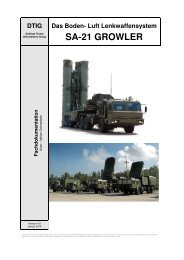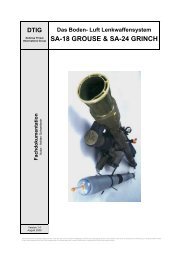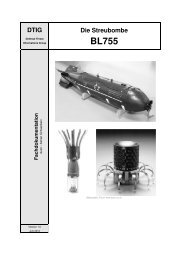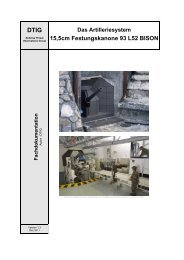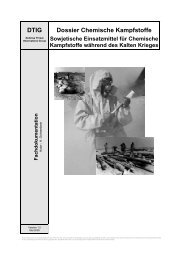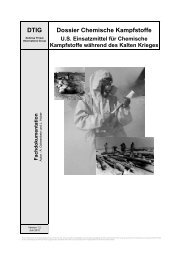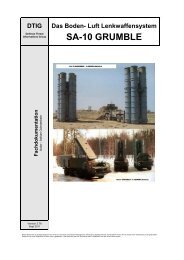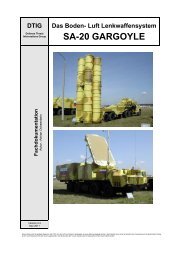RUSSIAN/SOVIET SEA-BASED ANTI-SHIP MISSILES Specia ... - DTIG
RUSSIAN/SOVIET SEA-BASED ANTI-SHIP MISSILES Specia ... - DTIG
RUSSIAN/SOVIET SEA-BASED ANTI-SHIP MISSILES Specia ... - DTIG
Create successful ePaper yourself
Turn your PDF publications into a flip-book with our unique Google optimized e-Paper software.
Russian Designation P-80 Zubr (3M80) P-80M Moskit (3M82) P-270 Moskit-M (3M82M)<br />
NATO / DoD Designation SS-N-22 Sunburn<br />
Manufacturer Raduga Design Bureau<br />
Guidance Mid-course autopilot; terminal active / passive radar seeker<br />
Warhead 320 kg HE semi-armor piercing or 200 kT nuclear<br />
Propulsion Solid-rocket accelerator, liquid-fuel ramjet sustainer<br />
Range 93 km 120 km 160 km<br />
Speed Mach 2.6 / 865 m/sec Mach 3 / 1000 m/sec<br />
Length 9.385 m 9.72 m 9.73 m<br />
Body Diameter 1,298 mm<br />
Wingspan 1,900 mm 2,100 mm<br />
Launch Weight 3,950 kg n.k. 4,150 kg<br />
Development Start 1973 n.k. n.k.<br />
Date Operational 1980 1984 Mid 1990s<br />
Launch Platforms Project 956 (Sovremenny), Project 1155B (Udaloy II) -class destroyers, Project<br />
1241.1MR (Tarantul III), Project 1239 (Bora / Dergach) –class fast missile corvettes<br />
Users Russia Russia and China<br />
Kh-35 (3M24) Uran (SS-N-25 Switchblade)<br />
Following a decision made in April 1984, OKB Zvezda started work on a "universal" (sea-, air- and<br />
coastal-launched) anti-ship missile, designated the Kh-35 (air launched) or 3M24 (sea launched). It<br />
was almost an copy of the US AGM-84 Harpoon, with the same concept, layout, and similar<br />
characteristics. The air-launched missile could be fired from altitudes from 200 to 5,000 m and had<br />
a range of 150 km. The missile was designed to engage small and fast vessels, such as enemy<br />
missile and torpedo boats and small assault ships. It could also attack transport ships with<br />
displacements of up to 5,000 tons. It was then assumed that such types of targets did not require<br />
sophisticated missile systems like the Moskit or Oniks, which were designed to engage frigates,<br />
cruisers, destroyers, and larger transport ships, especially those in convoys protected by frigates or<br />
destroyers. That is why the Uran missile is small and less sophisticated, as well as having a seeker<br />
optimized for low-RCS targets and able to track fast-moving objects. It has also low-weight highexplosive,<br />
fragmentation/incendiary warhead (believed to weigh 145 kg, though some sources say<br />
90 kg).<br />
In the early 1990s, a sea-launched version of the missile, dubbed the 3M24, was tested. This<br />
version has a range of 130 km and has a solid-rocket booster with a turbojet engine for cruise. The<br />
cruise phase is conducted at 10-15 m in altitude at a speed of up to 300 m/sec. The terminal phase<br />
is conducted at an altitude of 3-5 m at the same speed. The missile employs the ARGS-35 active<br />
radar seeker The typical sea launcher, designated KT-184, has four angled tubes. Four such<br />
launchers (16 missiles) are mounted on modified Tarantul-class vessels. The ships have been<br />
exported to Vietnam, and a single ship is used by the Russian Navy for trials and training of foreign<br />
crews. Space for four launchers can also be found on a single new Russian "Project 1154" frigate.<br />
The ship, the Neustrashimiy , was commissioned in 1993 and serves with the Baltic Fleet, but the<br />
launchers have never actually been mounted on it. Also, two "Project 1135" Krivak I-class frigates -<br />
the Legkiy and the Pilkyi - were modernized to the "Project 1135.2" standard, receiving two fourtube<br />
launchers for the 3M24 Uran system. Through 2002 the ships have not carried any actual<br />
missiles, only empty stands for the launchers. The ships also received the MR-755 Fregat (NATO:<br />
Half Plate) radar for target designation and the Garpun-Bal (NATO: Plank Shave) radar for fire<br />
control. The Garpun-Bal combines quickly switchable active and passive modes. In the active<br />
target- designation mode, it operates in I/J band and can detect and track up to 150 targets. The<br />
radar's range is 35-45 km. The passive channel searches for pulse and continuous-wave signals.<br />
When a signal is located, the radar identifies the hostile emitter from a library of up to 1,000<br />
signatures. The signal's bearing is also measured. The maximum range of the passive channel is<br />
over 100 km, depending on the frequency.<br />
Aside from Vietnam, the other export customer of the Uran system is the Indian Navy. Four Delhiclass<br />
destroyers are armed with 16 Uran launchers apiece. The ships are also equipped with<br />
Russian-made MR-755 Fregat and Garpun-Bal radar sets. Other Indian ships on which 3M24 Uran<br />
system is used are four P-25A type corvettes. They also have four quadruple KT-184 launchers.



